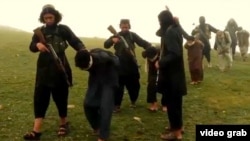When militants affiliated with the extremist group Islamic State (IS) issued a video showing prisoners being blown up with explosives, the Afghan Taliban condemned it as "horrific."
The four-minute video, which was released on social media on August 8, shows eight blindfolded men -- at least one of whom appears to be elderly -- being led across a hillside by fighters holding an IS flag.
The captives are forced to kneel on explosive charges, and are then blown up.
The video, in Arabic and Pashto, describes the prisoners as "apostates" and says they helped the Taliban.
But in a strongly worded statement on its website on August 11, the Taliban described the captives as "innocent civilians" who included "several white-bearded tribal elders and villagers."
Their killing by IS was an "un-Islamic act," the Taliban said.
"This offense and other such brutal actions by a few irresponsible, ignorant individuals under the guise of Islam and Muslims are intolerable," the statement reads.
The Taliban's outrage could be seen as out of place, coming from a group that has itself committed brutal acts over a quarter-century of insurgency and rule in Afghanistan.
But the grisly video, which was reportedly shot in Afghanistan's eastern Nangarhar Province in June, is more than a showcase by the IS group of its latest method of execution.
It is also an important piece of propaganda and a display of power in IS's ongoing turf war with the Taliban.
The video and the Taliban's response come amid fears that IS could grow its power base in Afghanistan, particularly if the Taliban -- currently embroiled in its own internal power struggle -- splinters or is consumed by infighting.
In late July, it was revealed that Taliban leader Mullah Mohammad Omar, who headed the movement for 20 years, had died in 2013 -- and that the Taliban had covered up his death for two years.
The movement has declared a new leader, Mullah Akhtar Mohammad Mansur. But key figures, including Mullah Omar's son and brother as well as members of the Taliban Supreme Council, have opposed Mansur's appointment and have refused to pledge allegiance to him.
The deep divisions within the Taliban could work to IS's advantage, however -- and help the extremist Sunni group attract more recruits as it strives to secure a foothold in Afghanistan.
Taliban leaders may fear that the rifts could prompt disgruntled field commanders and rank and file fighters to switch allegiance to IS. A series of major attacks in Kabul in recent days was widely seen as an attempt by the Taliban to show strength in the face of disunity.
The eastern province of Nangarhar along the volatile border with Pakistan -- and where the IS video was likely shot -- has seen a growing number of clashes between the Taliban and IS militants.
Militants loyal to IS seized substantial territory in Nangarhar province in June, with hundreds of fighters pledging allegiance to IS and pushing out the Taliban, according to Reuters.
Throughout June, the United States stepped up air strikes in Afghanistan in a bombing campaign against IS militants who pushed out the Taliban in Nangarhar.
But some analysts say IS does not pose much of a threat.
“IS inroads in Afghanistan are minimal so far” and limited to Nangarhar, said Thomas Ruttig of the Afghanistan Analysts Network, adding that it “remains a fringe group” in the country.
“IS’s chances to become a real factor are very limited, particularly as the Taliban mainstream seems to consolidate again after the recent crisis triggered by the report of Mullah Omar's death,” Rutting said.






